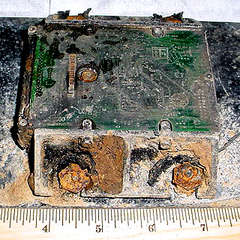Data recovered from the winchester from the Columbia shuttle crashed in 2003
 These were the heartbreaking video footage of 2003, when the Columbia Space Shuttle with seven astronauts on board caught fire and fell apart in the air a few minutes before landing. The crash occurred about 500 miles from the launch site at Cape Canaveral in Florida.
These were the heartbreaking video footage of 2003, when the Columbia Space Shuttle with seven astronauts on board caught fire and fell apart in the air a few minutes before landing. The crash occurred about 500 miles from the launch site at Cape Canaveral in Florida. Among the fragments of Colombia, which were carefully assembled, was the Seagate hard drive with a capacity of 400MB or rather what was left of it, because after the fire and falling to the ground from a great height, little could survive. On this hard drive was the information needed to complete the physical experiment - the CVX-2, which took place on the doomed Shuttle mission.
Among the fragments of Colombia, which were carefully assembled, was the Seagate hard drive with a capacity of 400MB or rather what was left of it, because after the fire and falling to the ground from a great height, little could survive. On this hard drive was the information needed to complete the physical experiment - the CVX-2, which took place on the doomed Shuttle mission.Employees of the Johnson Space Center, analyzing the shuttle crash, transferred these fragments of the hard drive to the engineers of the CVX-2 experiment (Critical Viscosity of Xenon) (Xenon Critical Viscosity), who in turn transferred them to Kroll Ontrack in Minneapolis Minnesota, to find out whether it is possible to recover at least some data. For the researcher Robert Berg (Robert Berg) and his team, this was the only, but very weak hope, of saving essential data from an experiment that investigated Xeon’s gas flows under microgravity conditions.
')
The people of Kroll Ontrack were able to recover about 90 percent of the 400 MB of hard drive data with a charred and broken case. A few years later, Robert Berg and his team analyzed the data and published the results of the experiment in the April issue of the journal (Physical Review E journal).
These showed that they could not be so wounded or that they were treated. Shear thickening. (Substance or gas) as a non-newtonian fluid.This experiment showed that just as in the case of whipped cream, which passes from a liquid state to a state close to a solid, after beating it up or strongly agitating - Xenon gas goes into a liquid state, if we do the same manipulation with small gravity with it. The phenomenon of sudden changes in the viscosity of a substance is called shear thickening. (Induction or shearing over a fluid (gas or liquid) increases its viscosity and the substance behaves like a non-Newtonian fluid).
It was a very complex experiment that required the continuation and detailed analysis of data from the hard drive in order to discover the “thinning” effect that was eventually found, as was the hard drive. So ends a twenty-year research project and at the same time puts an end to the terrible history of the Shuttle mission of Colombia.
Source (in English): blocksandfiles.com/article/5056
PS: I leave the physical research without translation, since it’s rather weak in Russian and with physics.
UPD: Thanks to sylvio and Kaberc for help with the translation.
Source: https://habr.com/ru/post/25124/
All Articles